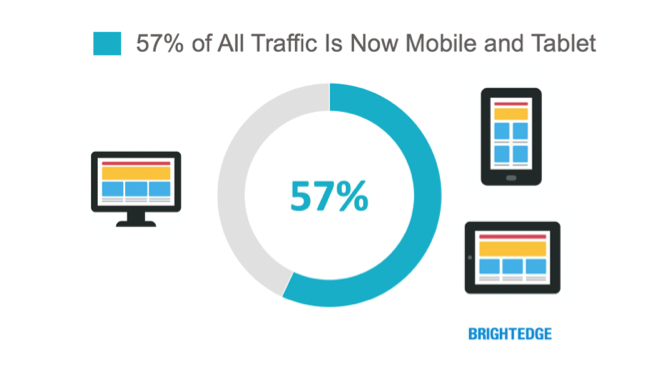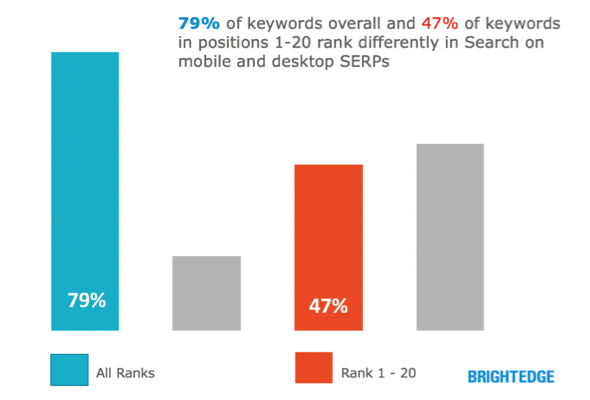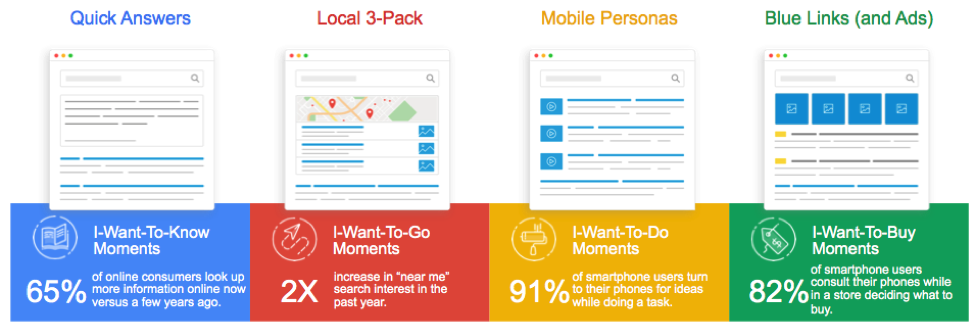According to a recent BrightEdge study, 57 percent of traffic now is coming from mobile and tablets. This fact emphasizes that audiences are more frequently relying on their mobile devices to execute their needs. However, even further beyond mobile, audiences are now multi-channel and multi-device.
While most marketers understand this, few are actively creating strategies to address the diverse digital world in which we live.

As SEO and content marketing converge, content performance has become a focal point for many organizations. Understanding your audiences’ multi-device habits is a critical step to implementing a content strategy to best reach and address consumers needs.
We Knew This Was Coming – Didn’t We?
Back in 2010, Google’s Eric Schmidt (CEO of Google at the time) recognized and predicted a mobile-first world, ushering in an era of “mobile first indexing”; an emphasis on page speed and user experience; and the creation of AMP.
Additionally, Gary Illyes of Google has stated that their mobile-first index will be coming sometime during 2018.
The impending arrival of a mobile-first index, as heralded by these leaders, emphasizes the growing need for search marketers to create mobile-first strategies.
Multiple digital marketers have already begun to address growing mobile audiences’ needs, looking to responsive design and page speed to improve their site’s user experience and influence their Google rankings and conversions.
The Time to Optimize Smarter Is Now
Separate BrightEdge research recently found that 47 percent of keywords in position 1-20 – and 79 percent of keywords overall – rank differently on mobile compared to desktop SERPs. That’s a huge discrepancy between devices, which can obviously have significant impacts on your SEO conversion goals.

As an SEO practitioner, it’s easy to get caught up in all of the daily tasks necessary for optimization. It’s easy therefore to optimize, or partially optimize, content one time and simply ignore the fact that mobile ranks are often different than desktop.
The question, therefore, is how many of us are tracking ranking and, most importantly, content performance based on device – and from that data, taking action?
If we begin to focus on the potential of two indexes, we can begin to compartmentalize strategies for our websites and content to meet these challenges.
Part of the challenge is being able to identify audience intent so that we can either optimize the content to perform at its best on both mobile and desktop or double down on creating unique content specifically tailored to the audience and the device they are using for content discovery.
According to the research:
Mobile micro-moments – intent-rich instants when people reach for a device with a specific goal to know and learn something, go somewhere, do something or buy something– now dominate how customers interact with brands on mobile. These changes in mobile culture have forced SEO to mature. Marketers must now understand their customers on a deeper level and create and deliver meaningful content that appeals to people during the various micro-moments that make up their customer journeys.
Impacting Your Mobile-First Ranking
The best strategies are data-driven. Leveraging your analytics and SEO platforms will provide you with insights into your audience’s behavior and how best to reach them.
With a mobile-first approach, it’s essential to understand the elements that impact mobile ranking. These include:
- User Experience: What is viewed first on a mobile device, and how that content correlates to the micro-moment of the user. In other words, the answer to the question they are trying to solve.
- Site Speed: Speed is an essential factor for mobile users. Your pages must load quickly, which often means implementing a variety of development tactics to keep the page/site “light.”
- Accelerated Mobile Pages (AMP): If you have content that can take advantage of AMP, do it. Studies have shown improved page views and click-through rates from AMP pages, not to mention Google often presents AMP results in a carousel in top positions, garnering improved exposure for your content
- Keyword Tracking on Both Mobile and Desktop
- Analytics and Dashboard Configuration
- Content Strategies: Align your content strategy with audience intent, while keeping the mobile-first experience top-of-mind.
To achieve these goals, you will need to audit your website and then prioritize the projects between technical/user experience as well as content creation and optimization.
Planning for Technical Improvements
Following a site audit, you should be armed with technical areas of improvement. Align those “fixes” along with technical projects that will help your website perform better in mobile. These especially include:
- Improving site speed (by reducing the amount of JavaScript on your pages leveraging tag management).
- Leveraging AMP where possible.
- Implementing Schema.org.
- Ensuring that your site is responsive and the right content (actionable based on the user intent for the page) on the page appears “above the fold” on a mobile device.
- Ensuring your URL structures are clean, non-duplicative and easy for Google to crawl.
- Ensuring canonicals are in place.
Once you have your technical SEO list, prioritize projects, and then be sure to embed yourself within other organizations within your company such as User Experience; Product Management; Analytics and Development teams to get the projects on their roadmap.
It isn’t just about taking these teams out for “drinks.” Rather, it’s about illustrating to them the ROI that they will receive from taking time to address these problems.
Developing a Mobile-First Content Strategy
Once you’ve identified the technical areas to be addressed to improve your content’s mobile experience; the next step is to build a strategy around your content. In order to do that, you will need data to understand your audience, their behavior, and which micro-moment you plan to align with their “buyer’s journey”.

When aligning your content strategy to the audience intent, consider how your content can align with micro-moments to target, reach, and convert audiences.
Creating content that aligns directly with micro-moments can lead to improved mobile rankings in Google. The key is to tailor the content around the elements the audience is looking for with a mobile-first perspective.
For example, if your business has multiple locations, you will want to develop unique content pages for each location. These pages can serve you well for both mobile and desktop, but the priority is on the mobile experience.
Not convinced? According to Think With Google, 76 percent of people who conduct a local search on their smartphone visit a physical place within 24 hours. Further, 28 percent of those searches result in a purchase.
Elements on location-based pages (“I want to Go” and “I want to Buy” moments) should include:
- Brand name
- Location
- Targeted keywords
- Map/directions
- Description of services
- Description of hours of operation
- Google My Business listing
- Fast/light pages
- Ideally, ensure that the page has Schema.org markup in place
As mentioned, in many cases, this content can be similar to the desktop version. The key differentiator is to ensure that the primary content elements such as location, hours of operations, services, and maps appear in order of priority when the user access the content from a mobile device.
One problematic approach that we have seen many organizations fall into is creating a generic “locations” page, which contains all of their locations. While at first appearance this solution may seem acceptable, expect when we step back and realize that 84 percent of “near me” or location-based search come from mobile devices.
Tracking Your New Content Performance
Now that you’re on your way to address technical issues and creating user intent based content for mobile audiences, it’s extremely important to create dashboards that show ranking improvements and losses for both desktop and mobile.
Additionally, it’s essential to correlate rankings to traffic, and then to conversion. In some cases, this means blending multiple reports. While this can be a pain, it’s essential to give you the knowledge and 360-degree view to pivot your tactics based on the content’s performance.
Conclusion
People have become accustomed to using mobile as an extension of their work and their lifestyles, leaving marketers with a wealth of data and channels to work within to achieve our audience reach and conversion goals.
Understanding the growing importance of a mobile-first world will help marketers optimize and organize their content strategies to align with audience intent.
Quick glance actions for a mobile-first content optimization strategy:
- Leverage data insights platforms and your analytics.
- Plan content based on data-driven analysis that aligns with your audience behavior and intent.
- Develop content with a mobile-first viewpoint.
- Work with your expanded teams to prioritize and complete technical and UX changes necessary to improve mobile ranking and user experience.
- Track and measure KPIs based on mobile and desktop – both are essential.
Image Credits
In-Post Screenshots taken by Michael Kirchhoff, September 2017






![Google AIO: 4 Ways To Find Out If Your Brand Is Visible In Generative AI [With Prompts]](https://www.searchenginejournal.com/wp-content/uploads/2025/03/sidebar1x-187.png)